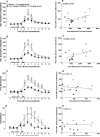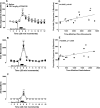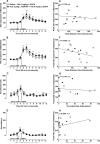Impact of metabotropic glutamate 2/3 receptor stimulation on activated dopamine release and locomotion
- PMID: 20585759
- PMCID: PMC2954604
- DOI: 10.1007/s00213-010-1914-8
Impact of metabotropic glutamate 2/3 receptor stimulation on activated dopamine release and locomotion
Abstract
Rationale: Activation of metabotropic glutamate (mGlu) 2/3 receptors may provide a novel strategy for treating schizophrenia. This effect is thought to be mediated through dopamine-independent mechanisms because mGlu2/3-receptor agonists have no considerable affinity for dopamine receptors. These agonists, however, reduce amphetamine-induced hyperlocomotion suggesting that they influence dopamine neurotransmission.
Objective: We evaluated whether the inhibitory effect of mGlu2/3-receptor activation on amphetamine-induced hyperlocomotion correlates with attenuated dopamine release. We also assessed whether mGlu 2/3 receptor activation has inhibitory effects on activity-dependent vesicular release of dopamine in behaving animals.
Methods: Microdialysis was used to measure extracellular levels of dopamine in the dorsal striatum (DStr) and nucleus accumbens (NAc) of freely moving rats. The effect of the mGlu2/3-receptor agonist LY354740 on dopamine release and locomotion elicited by amphetamine, electrical stimulation of the ventral tegmental area, or L-dopa was assessed.
Results: We find that the inhibitory effect of mGlu2/3 activation on amphetamine-induced hyperlocomotion correlates with an attenuated increase in dopamine release in the NAc and DStr. However, when dopamine levels were increased by electrical stimulation of dopamine neurons or by administration of the dopamine precursor L-dopa, activation of mGlu2/3 receptors had no effect on dopamine release or on behavior.
Conclusions: Activation of mGlu2/3 receptors attenuates amphetamine-induced dopamine release through a mechanism that does not affect activity dependent vesicular release, reuptake or synthesis of dopamine.
Figures




Similar articles
-
A metabotropic glutamate 2/3 receptor antagonist, MGS0039, increases extracellular dopamine levels in the nucleus accumbens shell.Neurosci Lett. 2006 Jan 30;393(2-3):127-30. doi: 10.1016/j.neulet.2005.09.058. Epub 2005 Oct 17. Neurosci Lett. 2006. PMID: 16233956
-
Modulation of amphetamine-induced dopamine release by group II metabotropic glutamate receptor agonist LY354740 in non-human primates studied with positron emission tomography.Neuropsychopharmacology. 2006 May;31(5):967-77. doi: 10.1038/sj.npp.1300902. Neuropsychopharmacology. 2006. PMID: 16177807
-
The mGlu2/3 receptor agonist, LY354740, blocks immobilization-induced increases in noradrenaline and dopamine release in the rat medial prefrontal cortex.J Neurochem. 2004 Jan;88(1):194-202. doi: 10.1046/j.1471-4159.2003.02125.x. J Neurochem. 2004. PMID: 14675163
-
Pharmacological and molecular characterization of the positive allosteric modulators of metabotropic glutamate receptor 2.Neuropharmacology. 2016 Dec;111:253-265. doi: 10.1016/j.neuropharm.2016.08.032. Epub 2016 Aug 30. Neuropharmacology. 2016. PMID: 27590915 Review.
-
A role for noradrenergic transmission in the actions of phencyclidine and the antipsychotic and antistress effects of mGlu2/3 receptor agonists.Ann N Y Acad Sci. 2003 Nov;1003:309-17. doi: 10.1196/annals.1300.019. Ann N Y Acad Sci. 2003. PMID: 14684454 Review.
Cited by
-
Activation of metabotropic glutamate 2/3 receptors attenuates methamphetamine-induced hyperlocomotion and increase in prefrontal serotonergic neurotransmission.Psychopharmacology (Berl). 2011 Oct;217(3):443-52. doi: 10.1007/s00213-011-2295-3. Epub 2011 Apr 13. Psychopharmacology (Berl). 2011. PMID: 21487651
-
G protein-coupled receptor modulation of striatal dopamine transmission: Implications for psychoactive drug effects.Br J Pharmacol. 2024 Nov;181(22):4399-4413. doi: 10.1111/bph.16151. Epub 2023 Jun 20. Br J Pharmacol. 2024. PMID: 37258878 Review.
-
Local modulation by presynaptic receptors controls neuronal communication and behaviour.Nat Rev Neurosci. 2022 Apr;23(4):191-203. doi: 10.1038/s41583-022-00561-0. Epub 2022 Feb 28. Nat Rev Neurosci. 2022. PMID: 35228740 Free PMC article. Review.
-
The mGluR2/3 agonist pomaglumetad methionil normalizes aberrant dopamine neuron activity via action in the ventral hippocampus.Neuropsychopharmacology. 2020 Nov;45(12):2106-2113. doi: 10.1038/s41386-020-0764-2. Epub 2020 Jul 14. Neuropsychopharmacology. 2020. PMID: 32663839 Free PMC article.
-
The excitatory-inhibitory balance as a target for the development of novel drugs to treat schizophrenia.Biochem Pharmacol. 2024 Oct;228:116298. doi: 10.1016/j.bcp.2024.116298. Epub 2024 May 21. Biochem Pharmacol. 2024. PMID: 38782077 Review.
References
-
- Antelman SM, Eichler AJ, Black CA, Kocan D. Interchangeability of stress and amphetamine in sensitization. Science. 1980;207:329–331. - PubMed
-
- Beninger RJ. The role of dopamine in locomotor activity and learning. Brain Res Rev. 1983;6:173–196. - PubMed
-
- Bjijou Y, De Deurwaerdere P, Spampinato U, Stinus L, Cador M. D-amphetamine-induced behavioral sensitization: effect of lesioning dopaminergic terminals in the medial prefrontal cortex, the amygdala and the entorhinal cortex. Neuroscience. 2002;109:499–516. - PubMed
-
- Cadoni C, Pinna A, Russi G, Consolo S, Di Chiara G. Role of vesicular dopamine in the in vivo stimulation of striatal dopamine transmission by amphetamine: evidence from microdialysis and Fos immunohistochemistry. Neuroscience. 1995;65:1027–1039. - PubMed
Publication types
MeSH terms
Substances
Grants and funding
LinkOut - more resources
Full Text Sources
Other Literature Sources

